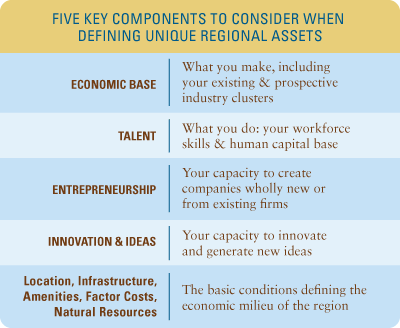How Innovation and Entrepreneurship are framing the New Economy
Special to EDA from Richard A. Bendis, the founding President and CEO of Innovation America
News of the activities of large American firms during the current era of economy recovery has communicated stark realties to everyone from policymakers in Washington to many Americans searching for better employment opportunities. A recent Commerce Department report shows that American companies laid off 2.9 million workers, while increasing employment overseas by 2.4 million. A prime example is that of General Electric. In a recent spotlight, it was revealed that nearly half of its workforce is located overseas and this ostensibly American firm is contributing much less than what was perceived to the tax base of the U.S. The Kauffman Foundation's Research Series on Firm Formation and Economic Growth indicated that for all but seven years between 1977 and 2005, existing firms have been net job destroyers, losing 1 million net jobs per year. By contrast, in their first year, new firms add an average of 3 million jobs, according to this study.

However, these developments were not news to many of our fellow practitioners in the Economic Development community.
For several years, our emphasis has been directed to supporting the growth of new high-tech firms and start-ups. As economic development practitioners, we are experienced in working with the strategic legacy industries in our geography, whether that legacy is in agriculture, manufacturing, shipping and logistics, scientific, or engineering. New firms in our regions benefit from interaction with like-minded people with similar industry background, not to mention the ability to integrate into existing supply-chains much faster.
To the credit and leadership of the Economic Development Administration, it has linked its funding allocation to articulated strategies that link key economic assets within cities and regions. These assets are many interrelating components including your capacity to innovate and generate new ideas incorporating academic and laboratory research, the area's existing and prospective industry composition, critical mass of workforce talent and skills, entrepreneurial capacity to create new companies and other geographic considerations whether natural or man-made. Industry cluster analysis is one lens and tool to consider the composition of our regions. We do not all have clusters based on the way they are defined and characterized in modern cluster theory, but we all have unique economic assets, strategic industries or innovative niches that are critical to mobilize regional innovation.
Still, in today’s knowledge-economy, where value is derived from creating, evaluating, and trading knowledge, the primary unit of emphasis and driver of economic growth is supporting our small and medium-sized enterprises (SMEs) and the entrepreneur who is the risk-taker at the center of the company. SME’s generate over 60 percent of net new jobs annually, employ 30 percent of high-tech, scientists, engineers, and information technology workers, and produce 13 to 14 percent more patents per employee than larger firms. Small firms are the true drivers of innovation in the U.S. In many examples, these firms embody the confluence in the application of technological advancement, the transformation of markets, financial risk-taking, and people enabling the transfer of knowledge and creation of wealth.
In supporting and accelerating the creation of SME’s, there remains much to do for practitioners and programs in the economic development community. In April, the U.S. private sector created 244,000 jobs. At this rate, it’s going to take seven years to get to full-employment. Another great concern is the growing wealth of large firms in reverse proportion to their number of employees.
This scenario only fuels our required focus on the support of innovation, entrepreneurs, and SME’s. Logically, the EDA has incorporated the support of innovation and regional innovation ecosystem that enable improved economic development organizations, that I refer to as “Innovation Intermediaries” to support the growth of local SME’s and provide a multitude of other key functions of innovation connectivity. And by innovation, it is not just defined only through the building of new products; it is the creation and transformation of knowledge and new processes and services that meet a market need, in addition to new products. It’s about new ways to partner, innovative interactions, entertainment forms, ways of communicating and collaborating. Innovation truly distinguishes the leaders in today’s economy.
For several years, our emphasis has been directed to supporting the growth of new high-tech firms and start-ups that are driven by advances in biomedical research, clean energy technology, better and stronger new materials, miniaturization of electronics and nanotechnology, and faster computing capabilities. As economic development practitioners, we have all worked on nurturing these advancements to research and technology with the goal of creating amenable environments for innovators and entrepreneurs so these people are grown, retained, and attracted by our local geographies.
It is time to review how far we have come with a focus on improving technologies and transcend that focus to technological innovation. To this end, the EDA can only strengthen its leadership.
EDA is in a position to lead the full paradigm shift to promoting Innovation Based Economic Development (IBED) through fostering the growth of regional innovation ecosystems that support and enable entrepreneurs and SMEs. Small businesses are the innovation-adopters around the globe, where large firms tend to be the innovation-blockers with in-house legal teams operating to protect precious market share. EDA must continue to strengthen its tools, instruments of innovation, resources, and finances to support the practitioners of IBED that support and accelerate the growth of SMEs, because the U.S is truly not alone in this race to innovate. There is intense and growing competition among nations and regions for well-paid jobs and improved living standards. From Australia to Finland, global industrialized nations have organized national innovation strategies that include small business support through gap financing mechanisms, knowledge-driven support services through advanced incubators and accelerators, and research parks and better networks for the exchange of knowledge among innovation professionals with business, government, academic and technical leaders.
We must continue to challenge ourselves in thinking beyond pushing out research and technology and truly mobilizing innovation. EDA has a mandate and mission to educate and direct this major transition to IBED. We should all complete key exercises like innovation road mapping, a comprehensive multi-step process for developing strategies and plans in relation to your unique regional assets that involves a critical mass of local business, industry, academic, philanthropic and government leaders. In future articles, I will expand more into the details of specific trends related to IBED and key supporting components like conducting innovation road mapping in your region.
Private services are defined as non-tangible items of value that are either consumed when purchased or at a later date by their terms of sale, such as school tuition or an airplane ticket. These are distinct from tangible items, or “goods,” such as oranges or motor vehicles.


